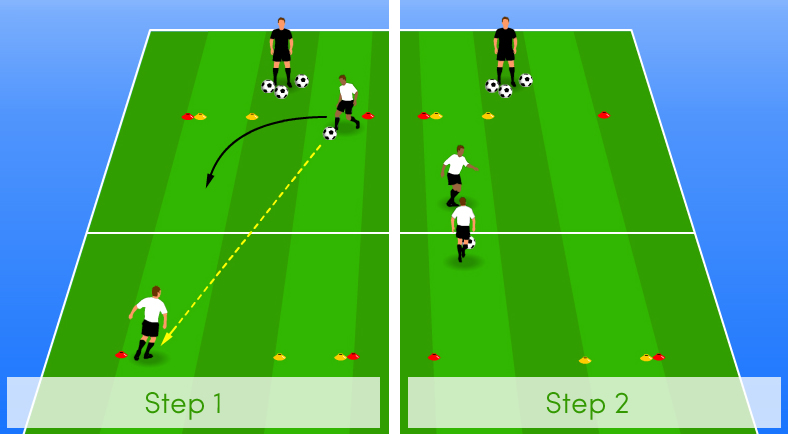Introducing 1v1 Defending
- Author: Ian Knapp
- Age Group: U7 to U17+
- Time: 20 minutes
Introduction:
This simple practice introduces the basics of 1v1 defending to your players, with a focus on the techniques involved in holding up your opponent, showing them in a particular direction (in this case, away from goal) and actually tackling them when the opportunity presents itself.
Setup:
- Set up a series of rectangular areas approximately 8 x 12 yards (but adapt for age and ability of players).
- Two players per area (or can have 4 per area taking turns).
- One coned gate or "goal" (yellow cones in below diagram) at each end, at opposite sides of the rectangle.
- One ball per pair of players. Coach with more balls if required.
Basic Rules:

- The defending player starts with the ball at their end (starting point is opposite side to the gate / goal) and passes it to the attacking player, who starts diagonally opposite them at the other end (see above).
- Attacking player controls the ball and tries to beat the defender to score through the gate at the other end.
- If the defender wins the ball, they can try and score in the attacker's gate.
- Switch roles once the ball goes out or a goal is scored - attacker becomes defender and vice versa.
- Keep score and keep rotating roles every turn for a set time.
- Once time is up, if you have multiple grids set up, move players round so they're facing a different opponent. Can even have a "ladder" system where players move up or down depending on if they won or lost.
- If 4 players sharing a grid, have each pair take turns. Those sitting out can help those playing by communicating with them as to what to do. Good grounding for working as a unit defensively.
5 Key Coaching Points:
Remember - adapt any coaching points for the age and ability of player you're coaching. With younger players, just picking one or two simple, key things like body shape and not diving in for example would be enough to start with. Don't overload the players with all the information - it won't sink in.
- Defending player's first priority is protecting the goal - as soon as the ball is travelling, they need to set off, arcing their run so they get in front of the goal (see black arrow in "Step 1" above. If they run straight to the attacker, the attacker can just pass the ball into the goal without even having to beat the player - demonstrate this to explain why arcing your run is important in this situation).
- Speed of approach to the attacker (too fast and you have no control and they can skip past you, too slow and you give them too much time)
- Body shape - can you show the attacker away from the goal with your body shape? Don't get caught "flat". Should be side on, on the balls of your feet, arm up to hold the attacker off, slightly crouched, ready to recover if the attacker goes past you or tackle if the opportunity arises.
- Don't dive in!!! A boxing analogy can work... if the boxer "dives in" when there is no opportunity, they will get hit - same with this - if you dive in the attacker will simply move past you. Wait for your moment when the attacker takes a poor touch.
- You don't HAVE to win the ball so if the opportunity doesn't present itself, don't try. If you simply hold the attacker up, you're doing your job as they can't score and your team mates can recover and help you out.
There are coaching points for the attacker too, but we're focusing on defending here, so rather than confusing the issue, we'll leave them out here.
Coaching Points (FA's 4 Corners):
| Technical | Psychological |
|---|
- Protect the goal - angle and speed of run important in doing this.
- Body shape - side on, balls of feet, crouch, arm up. NOT FLAT!
- Show the attacker away from the goal
- If the opportunity to win the ball arises, tackle with your front foot or if the player tries to go past you, you could use your back foot to block the ball.
- Timing of the tackle
- Keep your eyes on the ball, regardless of any tricks or fancy footwork the attacker may be using.
- Once you've won the ball, can you drive forward and turn defence into attack?
|
- Decision making - is there an opportunity to win the ball or should we just hold the player up?
- Awareness - is the player left or right footed, can we show them onto their weaker foot.
- Concentration - where is the goal? Can we make sure we keep it covered?
- Anticipate the attacker's next move based on their body shape and movement.
- Confidence to go again if you were beaten last time.
|
| Physical | Social |
|---|
- Strength to hold off the attacker and win the ball.
- Speed and fitness to keep pace with the attacker if they do go past you.
- Balance and agility to tackle, recover and block
- Speed at which you close down the attacker
|
- If 4 in a grid, communicate with the other players whilst you're waiting for your turn.
- Encouraging others
- Have fun!
|